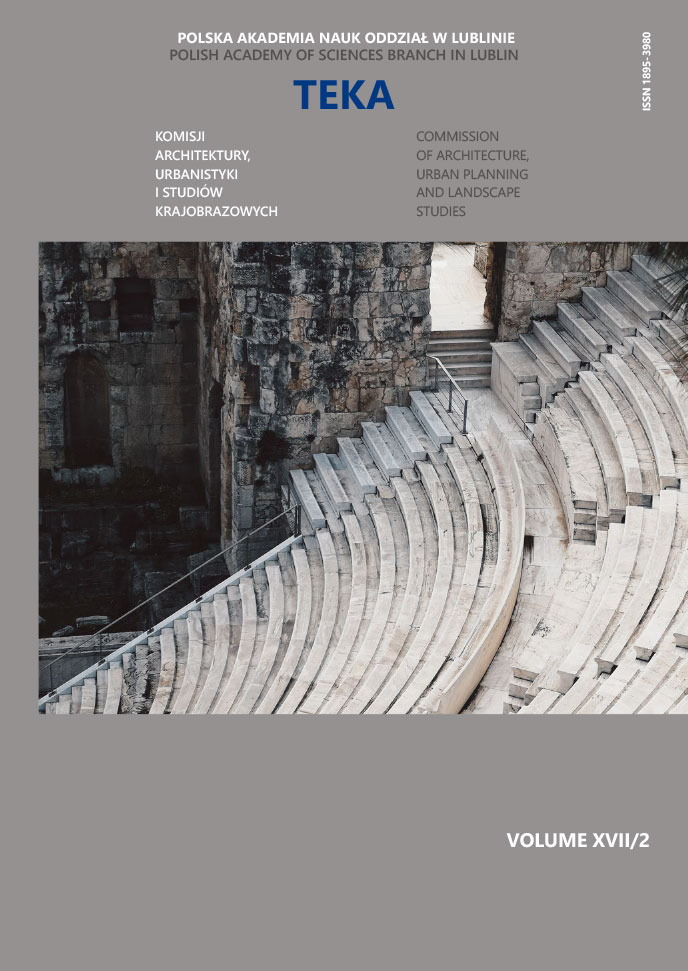Retrospection: genesis and durability of post‑war polychromes of tenement houses in the Old Market Square in Poznań
Article Sidebar
Open full text
Issue Vol. 17 No. 2 (2021)
-
Retrospection: genesis and durability of post‑war polychromes of tenement houses in the Old Market Square in Poznań
Andrzej Łubowski7-16
-
The importance of creating a cultural park within the historical center of Zamość. Good practices. The cultural park is not the Zamość Park
Katarzyna Kielin17-23
-
Flat pneumatic elements and their potential use in the construction of dwelling facilities within emergency housing systems
Witold Szymański24-36
-
The technology that meets modern human needs – criteria of assessment of smart home system
Dariusz Gaweł37-44
-
Use and functioning of the castle ruins in Iłża
Katarzyna Drobek, Maciej Trochonowicz45-54
-
Criteria of livable public spaces quality. Case study analysis on the example of selected public spaces Lublin, Poland
Agnieszka Chęć-Małyszek55-75
-
Voice in the discussion about the original architecture of the Powder Tower and the 16th century third defensive line in the Lviv Middletown
Mykola Bevz76-86
-
Building engineering issues in Architectural education in Poland, in context of actual Ministry of Science and Higher Education Regulations
Zuzanna Napieralska, Marek Piróg, Natalia Przesmycka, Agata Pięt, Marcin Zdanowicz87-95
Archives
-
Vol. 19 No. 2
2023-12-29 11
-
Vol. 19 No. 1
2023-12-19 13
-
Vol. 18 No. 4
2022-12-30 5
-
Vol. 18 No. 3
2022-12-27 5
-
Vol. 18 No. 2
2022-12-27 5
-
Vol. 18 No. 1
2022-12-27 4
-
Vol. 17 No. 4
2021-12-30 11
-
Vol. 17 No. 3
2021-12-30 9
-
Vol. 17 No. 2
2021-12-30 8
-
Vol. 17 No. 1
2021-12-30 8
-
Vol. 16 No. 4
2020-12-30 11
-
Vol. 16 No. 3
2020-09-30 10
-
Vol. 16 No. 2
2020-06-30 11
-
Vol. 16 No. 1
2020-03-31 10
-
Vol. 15 No. 4
2019-12-30 6
-
Vol. 15 No. 3
2019-10-31 9
-
Vol. 15 No. 2
2019-06-28 12
-
Vol. 15 No. 1
2019-03-29 13
Main Article Content
DOI
Authors
andrzej.lubowski@put.poznan.pl
Abstract
The article presents the artist's and researcher's own artistic experiences related to the implementation of painting decorations of tenement houses at the Old Market Square in Poznań. These are the works created in 1986, 1994 and 1997.
The first project was a consequence of quite unexpected incorporation of the polychrome of the tenement houses at the Old Market Square in Poznań. It was about 30 years, after World War II, when the polychrome on the reconstructed tenement houses was created. There was a need to restore the painting decorations by Edmund Łubowski on a tenement house at 39 Stary Rynek and the sgraffito by Józef Flieger at 99 Stary Rynek. The situation was a consequence of such advanced destruction that the works could not undergo further conservation processes. Due to the fact that the authors were then still alive, it was possible to consult the reconstruction process.
In 1994, the author received another proposal to make, according to his own design, a new painting decoration, made in the wet fresco technique, on a tenement house at 66 Stary Rynek. Later, in 2010, the restoration work was conducted in consultation with the author.
In 1997, a painting decoration was designed on the tenement house at 3 Paderewskiego Street, close to the urban interior of the Old Market Square. Based on the project, painting decorations were made in the silicate technique.
The artist's experience, drawn from the aforementioned works, has become the subject of qualitative research that correlates the passage of time and the type of wall painting techniques used as well as other technical conditions with artistic issues.
Keywords:
References
Błaszczyk I. (red), Stare Miasto, w Poznaniu. Zniszczenia – Odbudowa – Konserwacja 1945–2016, Wydawnictwo Miejskie Posnania, Poznań 2017.
Zwolińska K., Mała technologia Malarstwa, Wydawnictwa Centralnego Ośrodka Metodyki Upowszechniania Kultury, Warszawa 1989.
Kondziela H., Miasto Poznań (1955−1957), Ochrona Zabytków 12/1 (44), 72−76, https://docplayer.pl/amp/17688207-H-kondziela-miasto-poznan-1955-1957-ochrona-zabytkow-12-1-44-72-76.html.
Topolski J. (red), Dzieje Poznania, tom I, Państwowe Wydawnictwo Naukowe, Warszawa-Poznań 1988.
Przybek P., Materiały Malarskie, Wydawnictwo 400 d&, Kraków 2004.
Ślesiński W., Techniki Malarskie. Spoiwa mineralne, Wydawnictwo Arkady, Warszawa 1983.
Kostyrko T. (red), Sztuki plastyczne w Poznaniu 1945−1980,Wydawnictwo Poznańskie, Poznań 1987.
Warkoczewska M. (red), W cieniu ratuszowej wieży Kronika Miasta Poznania, 2003/2, Poznań 2003.
Zachwatowicz J., Ochrona zabytków w Polsce, Wydawnictwo Polonia, Warszawa 1965.
Kasprowicz R., Alois Riegl, Georg Dehio i kult zabytków, Oficyna Wydawnicza „Mówią Wieki”, Warszawa 2006.
Article Details
Abstract views: 224
License

This work is licensed under a Creative Commons Attribution-ShareAlike 4.0 International License.
Andrzej Łubowski, Instytut Architektury Wnętrz i Wzornictwa Przemysłowego, Wydział Architektury, Politechnika Poznańska
Pracownik Instytutu Architektury Wnętrz i Wzornictwa Przemysłowego Wydziału Architektury Politechniki Poznańskiej zatrudniony na stanowisku profesora. W latach 2016−2020 kierownik Katedry Rysunku, Malarstwa, Rzeźby i Sztuk Wizualnych i po reformie, przez rok, dyrektor Instytutu Architektury Wnętrz i Wzornictwa Przemysłowego na Wydziale Architektury Politechniki Poznańskiej. Od roku 2016 kierownik zespołu badawczego zadania Dzieło plastyczne w architekturze.
Urodził się w 1946 roku w Poznaniu. Studia w Akademii Sztuk Pięknych Warszawie ukończył dyplomem z malarstwa w 1971 r. w pracowni prof. Stefana Gierowskiego. Po ukończeniu studiów wrócił do Poznania. W 2010 r. uzyskał tytuł profesora sztuk plastycznych.
Działacz Związku Polskich Artystów Plastyków. Zorganizował ponad 50 wystaw indywidualnych swojej twórczości w zakresie malarstwa oraz brał udział w wielu wystawach zbiorowych w kraju i za granicą. Jego prace znajdują się w muzeach oraz innych zbiorach państwowych i prywatnych w tym w Kolekcji sztuki XX i XXI wieku w Muzeum Sztuki w Łodzi. Jest animatorem życia artystycznego, kuratorem licznych wystaw i sympozjów oraz laureatem wielu nagród.


